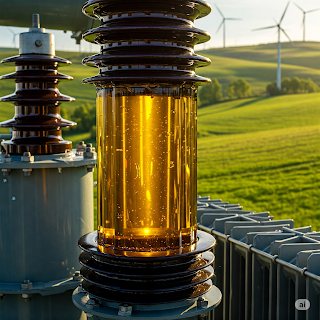Energizing a Sustainable Future
The global push for cleaner energy extends far beyond generation—it reaches into every component of the grid, including the humble transformer. Traditionally insulated with mineral oil, transformers are now going green by adopting sustainable vegetable- and seed-based dielectric fluids. Guided by rigorous IEC standards, these bio-based insulators offer improved fire safety, enhanced biodegradability, and a smaller carbon footprint. This article explores the science, standards, benefits, and challenges of “green” transformer oils, revealing how they’re reshaping the power sector.
The Role of Transformer Insulation in Power Systems
1.1 Why Insulation Matters
-
Dielectric Strength: Prevents electrical breakdown.
-
Thermal Management: Conducts heat away from windings.
-
Fire Safety: Determines flash point and fire propagation.
1.2 Limitations of Mineral Oil
-
Environmental Hazards: Low biodegradability and high toxicity.
-
Fire Risk: Flash points around 140 °C raise fire and explosion concerns.
-
Lifecycle Emissions: Petrochemical origin contributes to greenhouse gases.
Vegetable and Seed Oils: The Green Alternative
2.1 What Makes Them “Green”?
-
Renewable Feedstocks: Derived from soy, rapeseed, sunflower, and coconut.
-
Biodegradability: >80% biodegradation within 28 days (OECD 301B).
-
Low Ecotoxicity: Minimal harm if released to the environment.
2.2 Key Properties
| Property | Mineral Oil | Vegetable Oil |
|---|---|---|
| Flash Point | ~140 °C | 300–335 °C |
| Biodegradability | <10% in 28 days | >80% in 28 days |
| Viscosity (at 40 °C) | 10–12 cSt | 35–45 cSt |
| Pour Point | –30 °C to –20 °C | –10 °C to +5 °C |
| Dielectric Strength | ~60 kV (2.5 mm gap) | ~60 kV (2.5 mm gap) |
IEC Standards for Bio-Based Insulating Fluids
3.1 IEC 60296 – Mineral Insulating Oils
-
Basis for comparing new fluids.
-
Sets benchmarks for moisture content, breakdown voltage, and viscosity.
3.2 IEC 62770 – Bio-Based Insulating Fluids
-
Scope: Defines requirements for ester-based fluids.
-
Key Sections:
-
Dielectric Requirements (Clause 4): ≥50 kV breakdown voltage.
-
Thermal Characteristics (Clause 5): Viscosity and pour point limits.
-
Environmental Tests (Clause 6): Biodegradability ≥60% in 28 days; aquatic toxicity thresholds.
-
3.3 Certification Process
-
Type Testing: Independent labs verify compliance.
-
Routine Testing: Manufacturers test every batch for consistency.
-
Transformer Qualification: OEMs perform accelerated aging to validate long-term performance.
Advantages of Green Transformer Oils
4.1 Enhanced Fire Safety
-
Higher flash and fire points reduce ignition risk.
-
Lower severity of oil-related fires; improved personnel and asset protection.
4.2 Environmental Benefits
-
Rapid biodegradation minimizes soil and water contamination.
-
Reduced lifecycle greenhouse gas emissions.
4.3 Electrical and Thermal Performance
-
Comparable dielectric strength to mineral oil.
-
Slightly higher viscosity can improve heat transfer in slow-flow applications.
4.4 Regulatory and Corporate Drivers
-
Stricter environmental regulations (e.g., EU F-Gas phase-down).
-
Corporate ESG commitments: Lower carbon footprints and safer operations.
Case Studies: Transformers Going Green
5.1 European Distribution Network
A leading German utility retrofitted 500 kVA pole-mount transformers with rapeseed-based fluid. Over two years, no compromise in performance, zero environmental incidents, and a 75% reduction in CO₂-equivalent emissions related to fluid production.
5.2 North American Data Centers
An American data center operator specified coconut-oil ester in 10 MVA units. Fire protection studies showed mandatory sprinkler spacing could be increased by 30%, yielding capital savings on suppression systems.
5.3 Emerging Markets: India’s Grid Expansion
To support rural electrification, India’s REC Power introduced sunflower-ester fluid in distribution transformers. The higher fire-point allowed transformers to be placed within densely built villages, reducing transmission losses by 12%.
Technical and Economic Challenges
6.1 Cost Considerations
-
Upfront Premium: Vegetable oils cost 20–40% more than mineral oil.
-
Total Cost of Ownership: Lower risk-adjusted insurance and environmental remediation costs can offset the premium.
6.2 Material Compatibility
-
Natural esters may interact with certain gaskets, paints, and winding insulations.
-
OEM guidance and accelerated compatibility tests are essential.
6.3 Oxidation Stability
-
Esters can be prone to oxidation in presence of moisture and oxygen.
-
Mitigation: Use of antioxidants, vacuum dehydration, and hermetic sealing.
6.4 Cold-Weather Performance
-
Higher pour points necessitate consideration in sub-zero environments.
-
Solutions: Blends with synthetic esters or heater-equipped transformer designs.
Best Practices for Specification and Operation
7.1 Fluid Selection
-
Match ester type (natural vs. synthetic) to climate and application.
-
Review IEC 62770 test reports and certificate of analysis for each batch.
7.2 Installation Protocols
-
Flushing & Vacuum Filling: Remove residual mineral oil to prevent mixed-oil issues.
-
Moisture Control: Maintain <20 ppm water content post-fill.
7.3 Monitoring & Maintenance
-
Periodic dielectric spectroscopy and dissolved gas analysis (DGA).
-
Check acid number and interfacial tension to detect early oxidation.
7.4 End-of-Life and Recycling
-
Re-refining options: Remove contaminants and replenish antioxidants.
-
Biodegradable, non-hazardous disposal if recycling is not feasible.
The Road Ahead: Innovations & Market Outlook
8.1 Next-Generation Biofluids
-
Nanofluid Additives: Enhance thermal conductivity with eco-friendly nanoparticles.
-
Hybrid Formulations: Blends of natural esters with high-temperature synthetics.
8.2 Market Forecasts
-
CAGR of ≈7% in bio-based transformer oil market (2024–2030).
-
Growth driven by grid modernization, data center expansion, and stricter fire codes.
8.3 Policy & Incentive Drivers
-
Potential tax credits for renewable insulating fluids.
-
Inclusion in green building and industrial certification programs (e.g., LEED, BREEAM).
Conclusion: Powering a Greener Grid
The shift from mineral oil to sustainable vegetable and seed oils marks a significant stride toward decarbonizing grid infrastructure. Underpinned by robust IEC standards, green transformer fluids deliver improved safety, environmental stewardship, and long-term cost savings. As global utilities and industrial operators race to meet net-zero targets and enhance resilience, bio-based dielectrics will play an increasingly vital role in powering a cleaner, safer, and more sustainable energy future.
Related Articles & Further Reading:
What are green buildings
Advanced Dielectric Materials for Next-Gen Power Systems


No comments:
Post a Comment